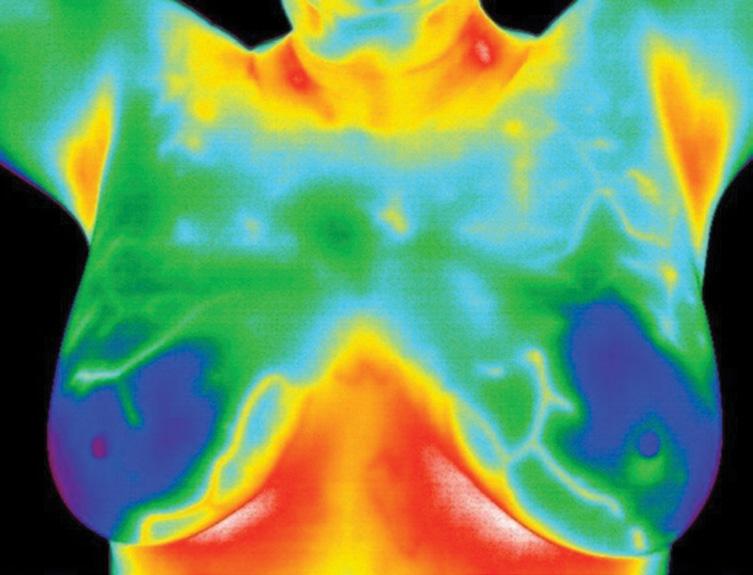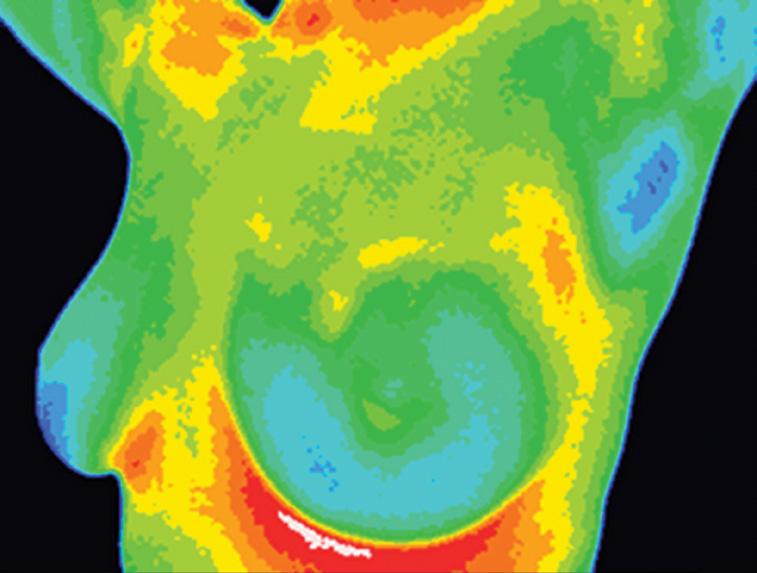
4 minute read
MAMMOGRAPHY VERSUS THERMOGRAPHY

Advertisement
by April Beaman
What’s the difference between mammography and thermography? Is thermography better than mammography? Does it replace mammography? There’s often confusion on this subject by thinking one replaces the other. One could say comparing these two breast screening tools are like comparing apples to oranges. Let’s dive a little deeper by first looking at the differences between the two.
Mammography
Mammography is an X-ray that utilizes ionizing radiation to image the internal structure of the breast. During a mammogram, the breasts are positioned and compressed between two plates. Two X-ray images are taken of each breast, one from the top and one from the side. A mammogram is a structural test, its purpose is to detect a change of the anatomy within the breast, such as a mass or tumor. A radiologist studies the X-ray images to look for abnormalities, specifically densities and calcifications.
Thermography
Thermography is a pictorial representation of the heat emissions of breasts. Think of a thermogram as a heat map that depicts temperature variations and thermal patterns. Thermography utilizes a specialized infrared camera that does not touch or emit any radiation to the body. Because thermography does not use compression, the entire chest, including the breasts and axillary regions (armpit), are imaged. There’s a total of six images taken in a breast series with anterior, oblique, lateral and inferior views. A thermogram is a functional test; its purpose is to detect physiological activity of the breast tissue. A thermologist studies the thermal images to look for abnormalities, specifically uneven temperature variations and irregular vascular patterns.
Comparing Apples to Oranges
Because mammography is a test of structure (anatomy), it can locate a mass or a tumor that already exists within the breast. Breast thermography is a test of function (physiology). It cannot detect the exact location of a tumor; it detects heat and inflammation in precancerous and cancerous tissue as well as the area surrounding a tumor. Isn’t mammography a better test then if it can locate a tumor? Breast abnormalities such as tumors don’t just suddenly appear. Long before you and your doctor feel a lump, or it is discovered by a mammogram, its cellular contributors are hard at work behind the scenes. Cancer cells require a blood supply and an ever-increasing need for nutrients in order to survive and proliferate. Being aggressive, these
cells create their own pathway to obtain this nourishment and lifeforce. In order to do this, the cells send out chemical messages to open existing blood vessels, recruit dormant vessels and create new ones. This process, known as neoangiogenesis, results in an increase in regional surface temperatures of the breast. Mammograms and physical exams cannot detect this early-cellular, physiological process, which typically occurs within the breast tissue 5-10 years before the slightest growth of a lump. Since functional changes precede structural changes, thermography can provide valuable information in the early indication of breast changes and disease. Further, these early warning signs can alert a physician to monitor a woman closely and, more importantly, put forth preventative measures to help reduce certain risk factors of breast cancer.
Early Detection and Prevention
By now, everyone has heard that early detection saves lives and prolongs life expectancy. However, if cancer is detected early, this means you already have cancer. Shouldn’t prevention take precedence over detection? Prevention means not getting cancer in the first place. In my opinion, if there’s any hope of reversing the current epidemic trend of breast cancer our physicians need to come up with a more proactive approach, which should be the standard for patient assessment. The process of cancer starts with one abnormal cell; it takes several years—up to 10—for that one abnormal cell to replicate to one billion cells. One billion cells produce a detectable lump that is about the size of eraser head. This is the size of a lump that can be detected with mammography. Is this truly an early finding? Should you wait until a tumor has formed and grows large enough to be detected by a mammogram as is our current standard of care for breast screenings? The valuable information provided by a thermogram can help a physician develop an action plan to take proactive measures to improve your breast health or even reverse certain risk factors to prevent the disease in the first place. A routine thermogram can empower you to take a proactive approach, to take breast health into your own hands. Evaluate your lifestyle and dietary choices. Make simple changes and employ self-care techniques based on your thermographic findings. These simple changes, though they may seem small, can have a big impact not only with breast health, but overall health. True prevention!
April Beaman, RDH, CTT, is a medical thermographer, certified by the Professional Academy of Clinical Thermology, and a professional member of Breast Thermography International. She has worked in the wellness industry for over 15 years and is an advocate for taking a proactive approach and staying well informed regarding one’s health. She provides thermography screenings and wellness support for men and women of all ages and is the owner of CT Thermography, located in Farmington with satellite offices in Glastonbury, CT and Hadley, MA. Connect at 860-415-1150 or CTThermography.com. See ad on page 6 and October free breast health Zoom webinars in Events Calendar section.
GROW
YOUR BUSINESS
Secure this ad spot! Call or text us for special ad rates.






